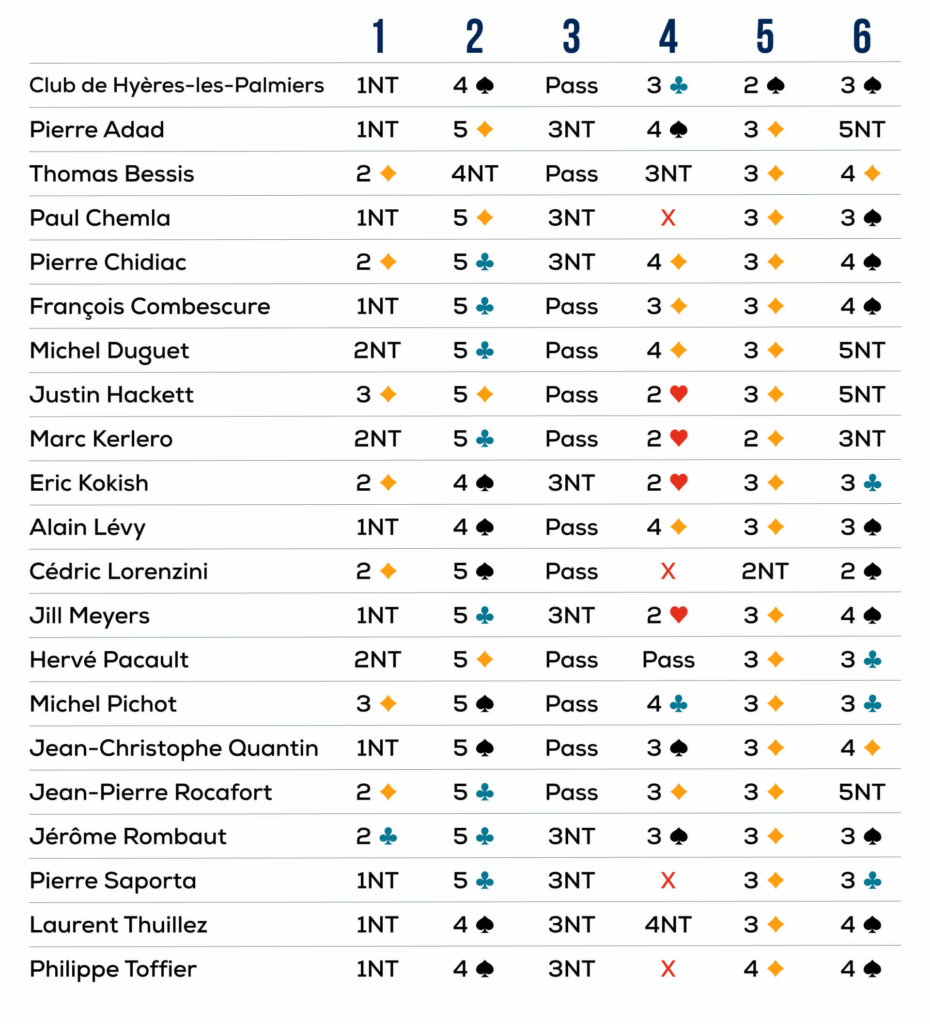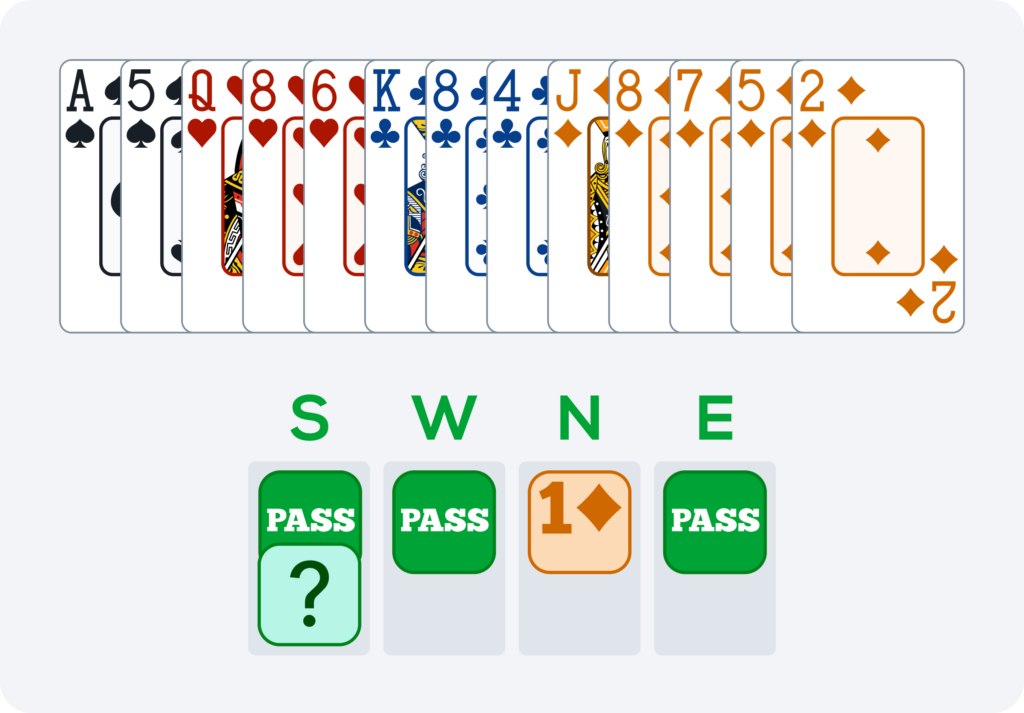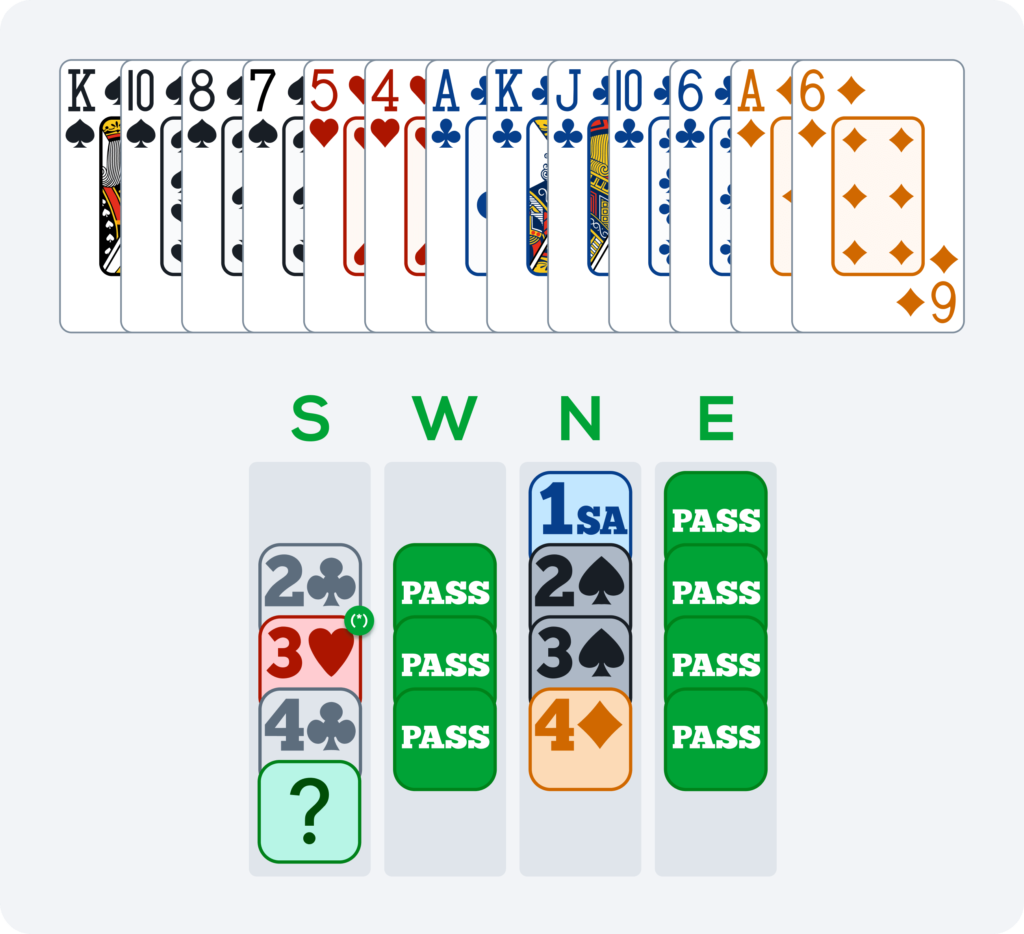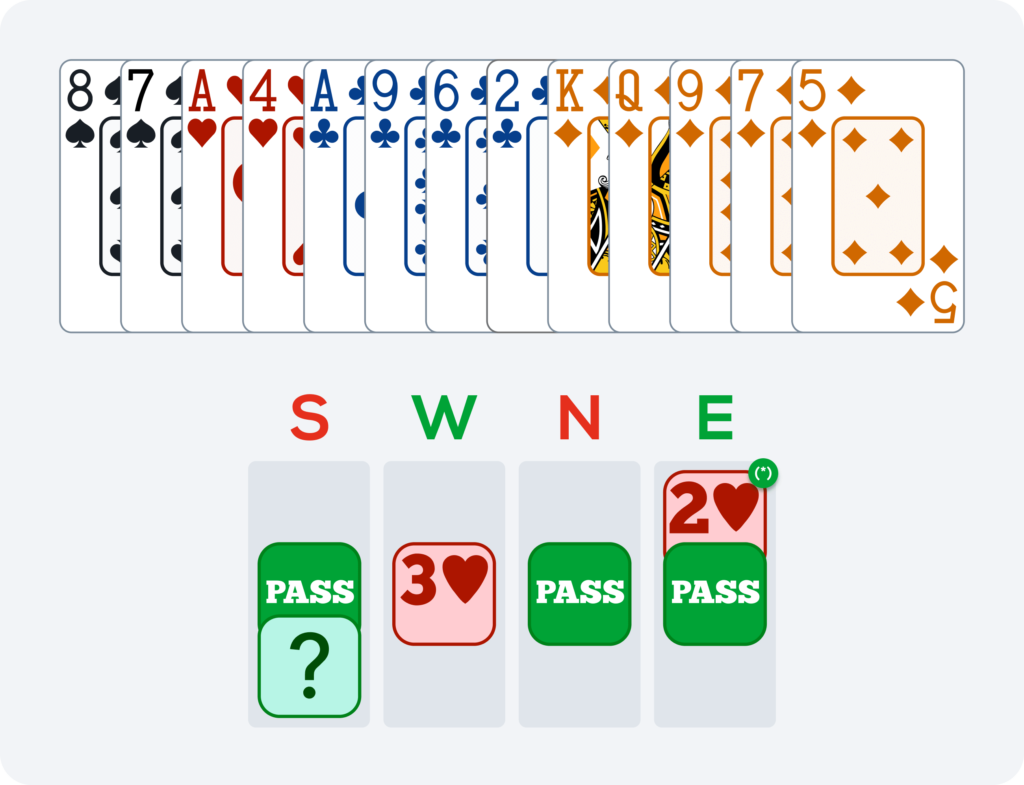
May bidding contest: the results!

Summary
Experts’ answers
Deal 1: Diamonds or No-trumps?
Deal 2: The search for the missing control
Deal 3: The great leap
Deal 4: Tangled up
Deal 5: Not even frightened
Deal 6: Broken heart
Winners
Share your opinion
The experts’ answers summarised

Deal 1: Diamonds or No-trumps?

As the experts’ responses show, inverted minor-suit raises continue their steady progression to the heart of the elite; particularly amongst our young stars.
Lorenzini and Thomas Bessis: “2♦. With this inverted minor, we are protected by our initial pass and can use the 2♦ bid to show 10-11 HCP and five-card diamond support. 3♣ (invitational diamond raise) would show a more unbalanced hand.” They are backed up by the “elders”, who are not lacking a sense of humour and have long been followers of this system, such as Rocafort: “2♦. I’m used to it: there is always a deal publicising inverted minors. We’ve done that now and can move on to the following deals, which might be a bit more complex” and Chidiac: “2♦. Inverted minor-suit raise showing, as a passed hand, a hand with a diamond fit and 10-11 HCP. I wonder what you do if you don’t play inverted minors!” The hand seemed too weak for many experts to get carried away. Only two opted for a 3♦ bid and three chose 2NT, including Pacault, who justified his choice as follows: “2NT. My opening style of “playable diamonds” implies that Opener has solid diamonds (if the hand is balanced) and strengthens the South hand. I choose 2NT over 3♦, partly due to consideration of stoppers and partly because 3♦, without being a pre-empt, is more generally bid by a hand of 8-9 HCP with more distribution.” The majority, however, opted for a more sensible 1NT bid.
Three arguments appear time and time again in the comments: the diamonds are poor. Jill Meyers: “1NT. I am debating between 1NT and a limit raise in Diamonds but my diamonds are too ugly, so I’m choosing 1NT.” The honours are scattered. Hyères Bridge Club: “1NT. Hand with scattered honours, not worth a 2NT bid” gives the same analysis as Quantin and Saporta: “1NT. With three honours in the three suits outside Diamonds, this response is better than an encouraging jump to 3♦.” The hand is too balanced. Chemla: “1NT. Perhaps a slight underbid but it is still the bid the least far away from this hand.”
Remember: Carefully discuss all your ways of supporting with a minor fit before and after an initial pass. Without losing sight, of course, of the fact that game in a minor is… 3NT!!
Scores Deal 1
1NT: 100 (10 votes)
2♦: 50 (5 votes)
2NT: 30 (3 votes)
3♦: 20 (2 votes)
2♣: 10 (1 vote)
Deal 2: The search for the missing control

(*) Hope for slam in Spades.
The first debate is about the meaning of the 3♠ bid over 3♥. Nothing to say; good trumps; no club control; max hand; encouraging? For the most part, it was a positive bid with good trumps, which explains why the majority did not resign themselves to settling for 4♠. But the tactics chosen differed for everyone who went past game. Let us begin with the “technicians” who opted for 5♠, a bid meaning: “Partner, do you have a heart control? If so, bid slam.”
Lorenzini: “5♠. My partner’s 3♠ response confirms decent trump quality (3NT, otherwise, would have shown poor trumps). Reassured about that, it is clear that a 4♠ bid would be insufficient since I hold three key cards and a source of tricks in Clubs. I would therefore have said 5♠, a bid that asks my partner to bid slam with a control in Hearts.”
In the same category of ideas, the bid that received the best score was 5♣. It also shows the lack of a heart control but insists on the second suit, which might lead to a grand slam being bid; who knows?
Combescure: “5♣. I do not think I am strong enough to force to slam (5♠) with North having a heart control (especially with such mediocre trumps) but I am too strong to settle for 4♠. 5♣ should deny a heart control and express the desire for slam without insisting on it, with seemingly good clubs (we did not bid 5♦).”
Finally, the third option: a 5♦ bid, once again to ask for a missing heart control. Chemla: “5♦. 3♠ then 4♦ were a double encouragement. Though with the two red-suit controls, you might be amazed that North did not bid Blackwood. He might only have one ace.” Adad: “5♦. That might not be the ideal bid for finding 7 Spades but it ensures that you will avoid playing in 6 Spades with the Ace-King of Hearts to lose (I admit that 3♠ confirmed slam interest and showed the good-quality trumps that 3NT would have denied).”
Finally, the last choice, selected by Bessis, who was also convinced that he would find his partner with a good hand: “4NT. As though a missing control could prevent me from bidding Blackwood… When I hold the King of Trumps, Ace-King of Clubs and the Ace of Diamonds and my partner shows a sign of encouragement, it is almost impossible for him not to have a heart control… At this stage, I prefer to check that we have enough key cards and, in particular, the Queen of Trumps, rather than a heart control.” More practical than technical but it is always delicate to choose between a cookie-cutter bid that could lead to a ridiculous result and a technical bid that describes your hand to the opponents too much…
Five experts out of twenty-one, however, displayed a surprising amount of pessimism, including the usually rather optimistic Thuillez: “4♠. We could be missing the Ace-King of Hearts and Queen-Jack of Spades and we would be in danger at the 5-level.” It is true that, with at least 30 combined HCP, it would still be unlucky if the 10 missing HCP were precisely those ones! All the same, Kokish points out that we would still be in danger at the 5-level opposite: ♠AJ63 ♥QJ6 ♦KQJ4 ♣Q3.
Remember: The technical bid of 3♥ in this sequence certainly looks good; but if you do not discuss the meaning of the continuations, it will be of little use to you.
Scores Deal 2
5♣: 100 (8 votes)
5♠: 80 (3 votes)
4♠: 60 (5 votes)
5♦: 50 (4 votes)
4NT: 10 (1 vote)
Deal 3: The great leap

(*) Weak, six cards.
You need a Funbridge Premium or Premium+ subscription to keep reading.
To read the rest of the article, you must be subscribed to the Premium or Premium+ offer.




Interesting
shar4at
Participated but no diamonds received
mnordgren also no diamonds